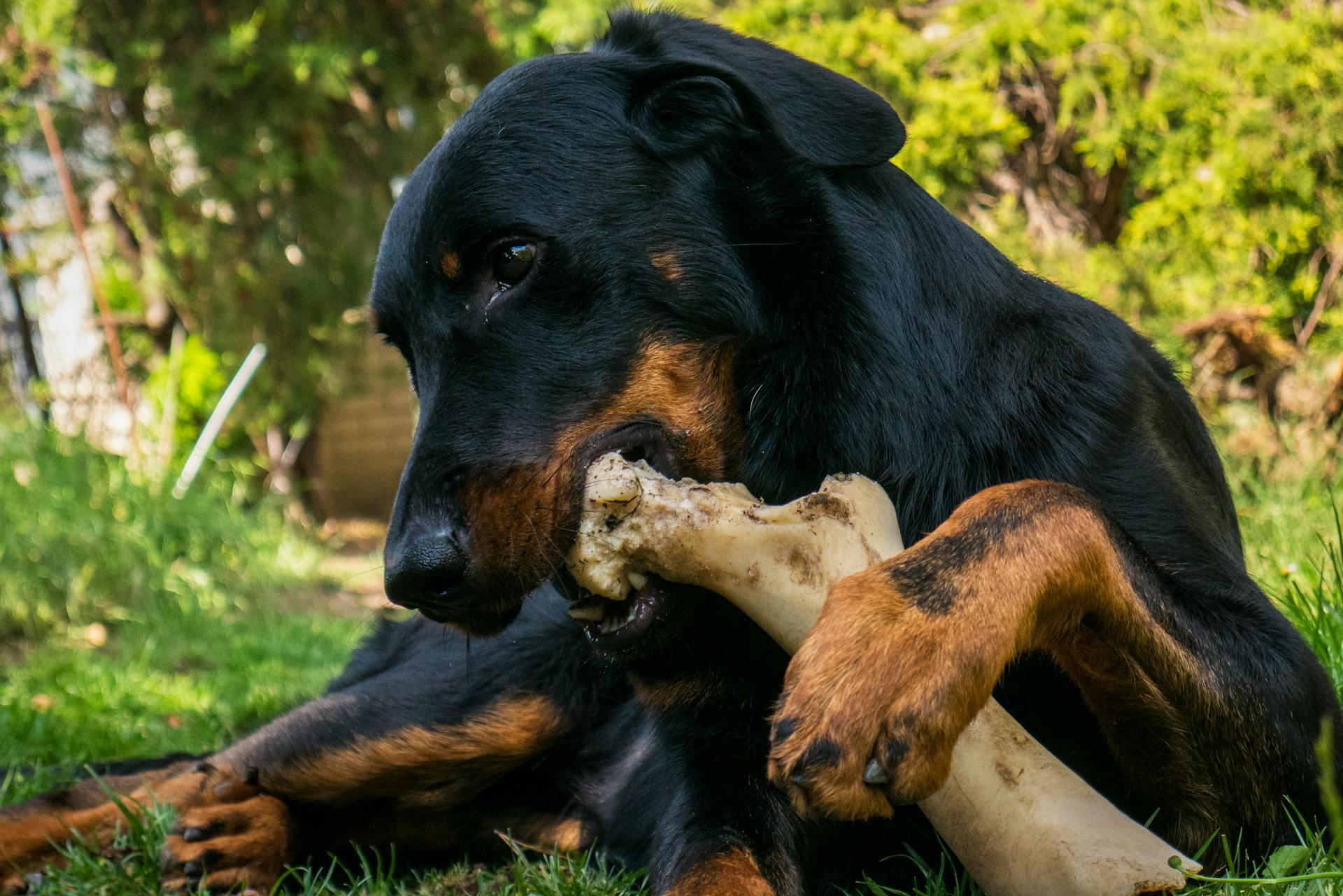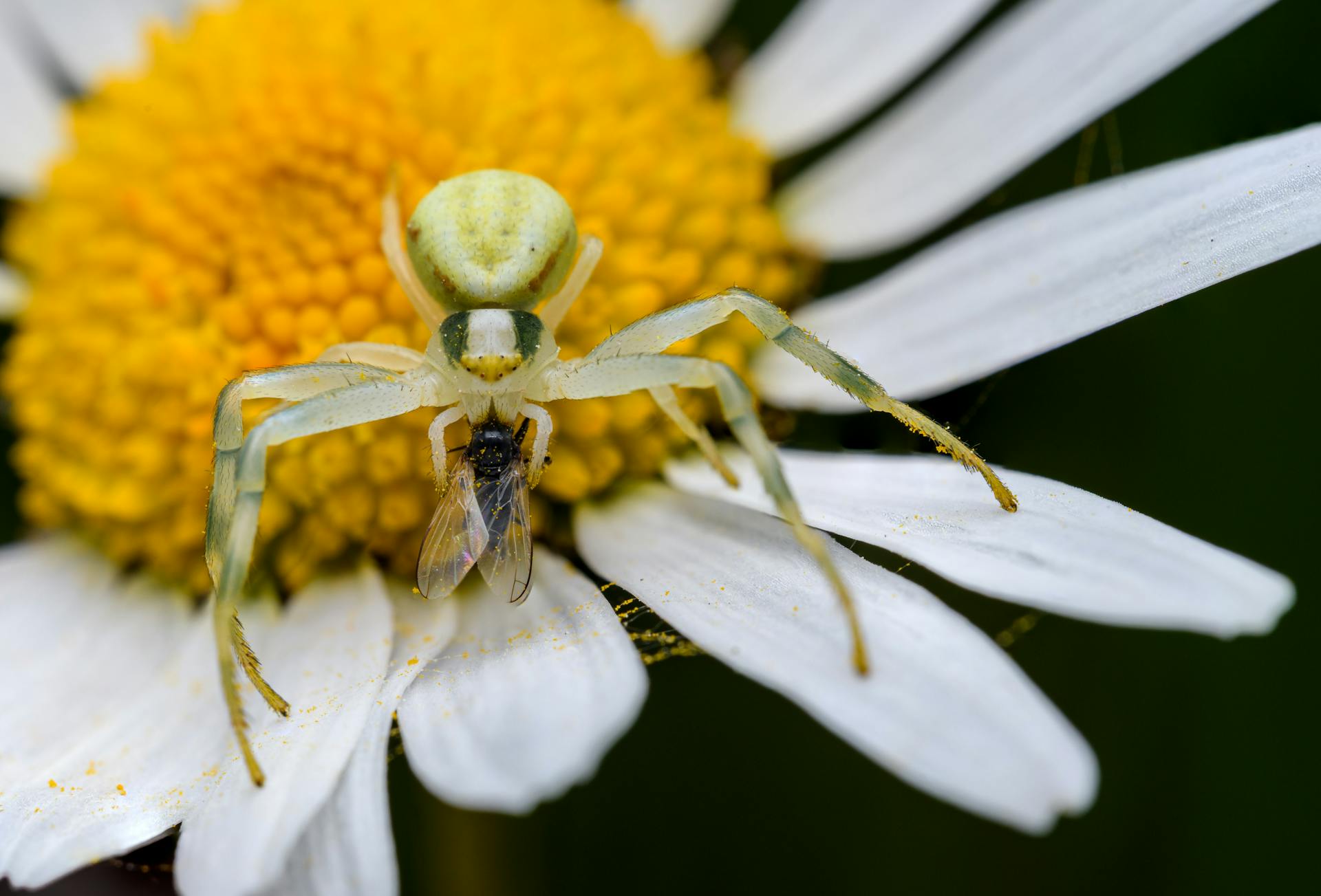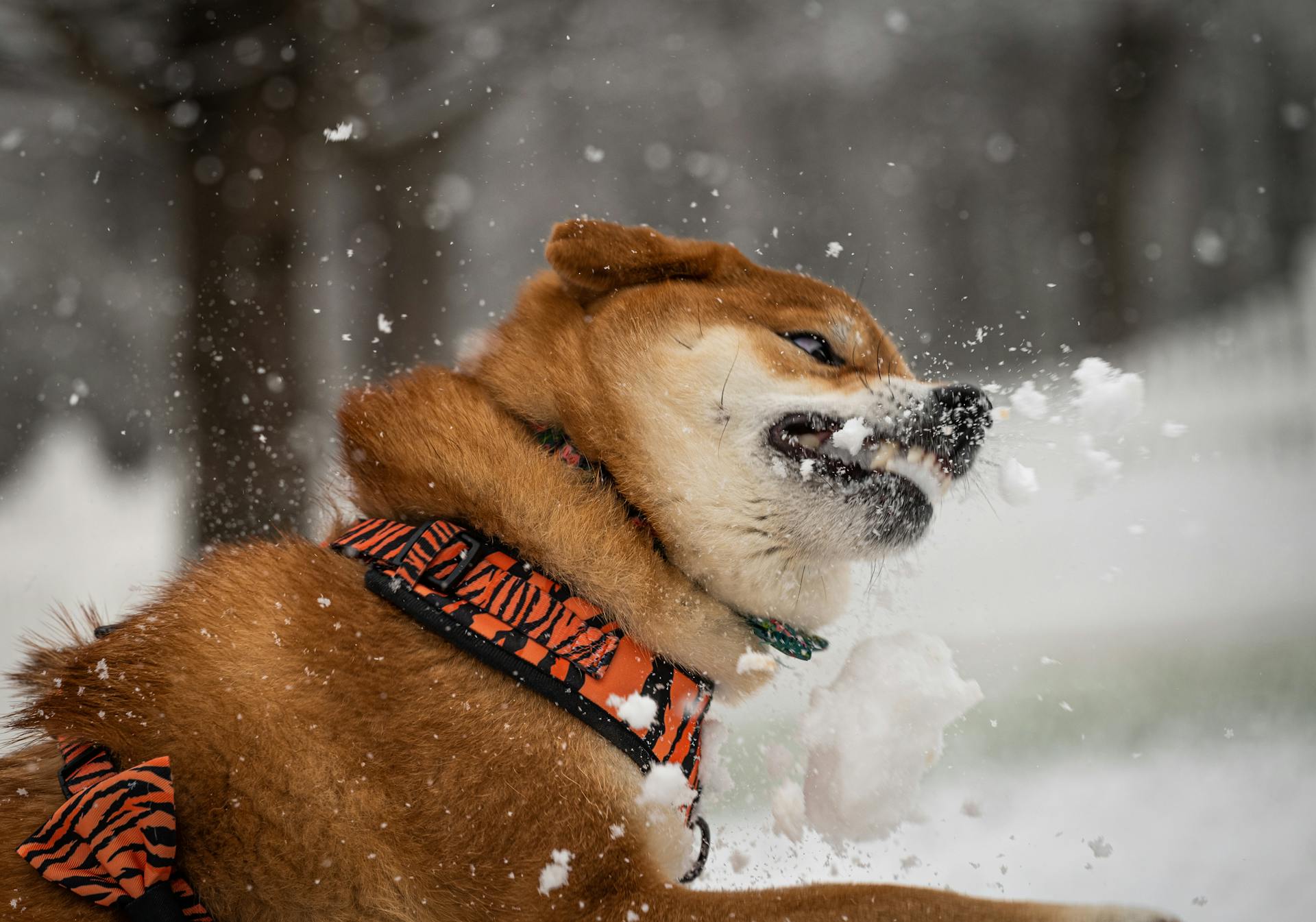
Husky dogs are known for their strong prey drive, which can sometimes lead to biting if they're not properly socialized and trained.
Husky dogs are highly energetic and require regular exercise to keep them calm and focused.
Their strong prey drive can be a challenge for inexperienced dog owners, but with the right training and socialization, huskies can learn to inhibit their biting instinct.
In fact, huskies are one of the top breeds that require early socialization to prevent biting and aggression.
A well-trained husky can be a loving and loyal companion, but it's essential to understand their unique needs and characteristics to ensure a harmonious relationship.
Why Husky Dogs Bite
Huskies can bite for a variety of reasons, including not being properly socialized as puppies. If a puppy doesn't spend enough time with its mother and litter before being adopted, it may not learn the difference between a gentle nip and a harder bite.
Discover more: Training My Dog Not to Bite
Some huskies may mouth or nip during play, especially if they're excited or being chased. Herding breeds, like huskies, may also nip or bite as a natural instinct.
Aggression or fear can also cause huskies to bite. If a husky is tense, nervous, or exposing its teeth, it's likely biting out of aggression rather than play.
Medical problems, lack of socialization, and scary situations can all contribute to aggression in huskies. For example, a thorn in their paw or a skin rash could lead to an outburst of violence.
Here are some warning signs to look out for in a husky:
- Medical problems
- Lack of socialization (e.g. never being around people)
- Scary situations (e.g. being given an injection, transported in a small space)
- Resource guarding (e.g. protecting food, toys, or belongings)
- Territorialism (e.g. defending "their territory")
If you notice any of these signs in your husky, it's essential to address the issue with a professional dog trainer.
Understanding Inhibition
Bite Inhibition is a set of skills taught to a dog so that he can control the pressure exerted by his bite and to over ride the drive to bite down on an object.
Puppies learn Bite Inhibition from their mothers and siblings through natural interactions, such as being scolded for biting too hard while nursing or playing. This early exposure helps them develop a tolerance to frustration and stressors.
A dog's prey drive is a natural instinct that can be triggered by moving objects or high-pitched noises, leading to a mock "attack" on a human victim. Unless intervened, this can result in serious injury.
Reasons for biting include lack of proper socialization as puppies, mouthing or nipping during play, or biting out of aggression or fear.
Here are some common reasons for biting, categorized by age and behavior:
What Is Inhibition?
Inhibition is a vital skill for dogs to learn, and it's essential to understand what it entails. Puppies learn Bite Inhibition from their mothers and littermates through play and socialization.
Mother dogs intervene when puppies bite too hard, refusing to nurse or scruffing their muzzles to signal "stop using your teeth in that way!" Siblings also issue high-pitched screams to alert puppies to ease up on the biting.
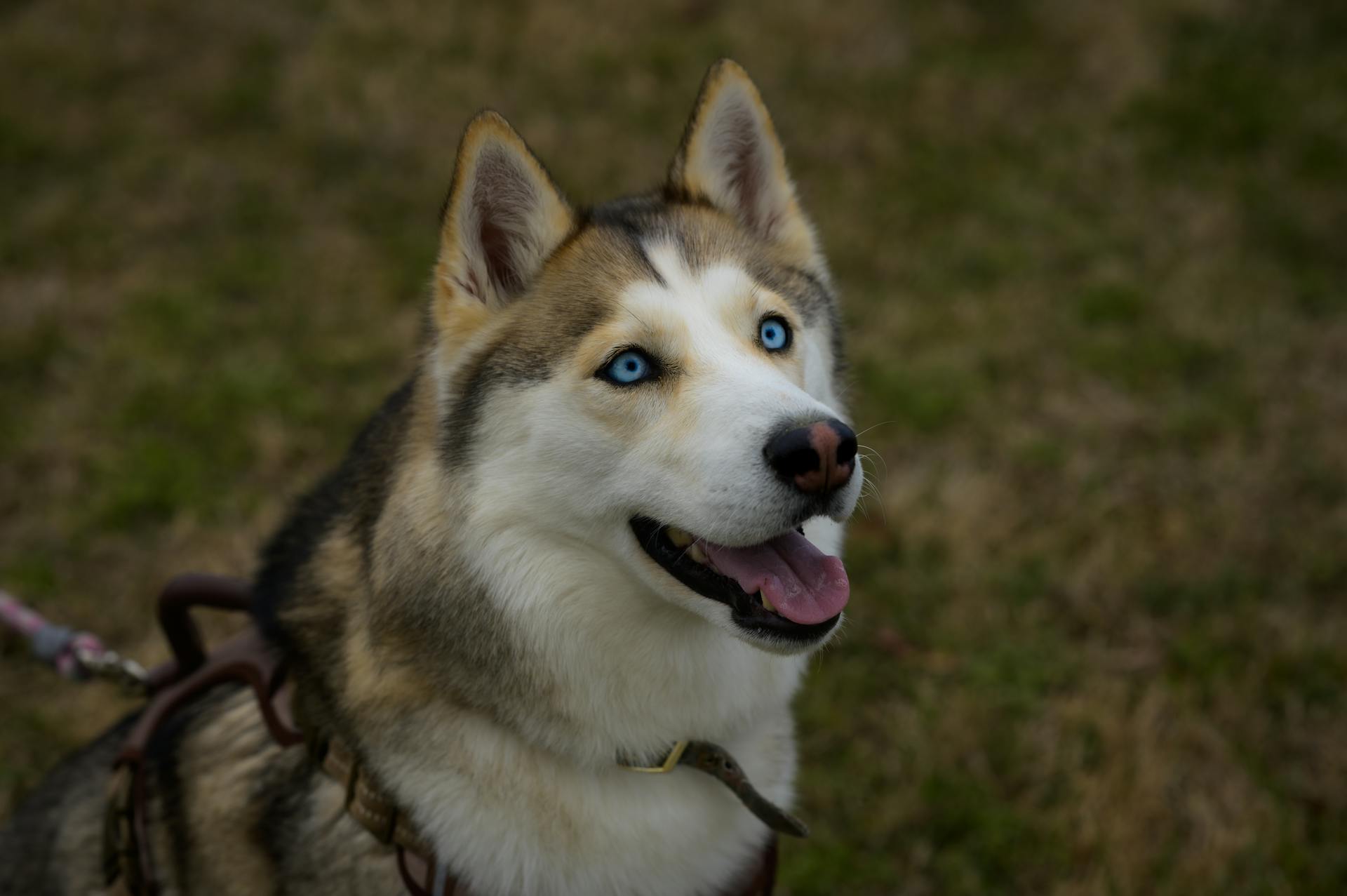
This natural process helps puppies develop a tolerance for stressors and learn to control their biting. Puppies that don't receive early exposure to stressors may become quick to anger and prone to problem biting.
In dog training terms, Bite Inhibition refers to a set of skills taught to a dog to control the pressure exerted by their bite.
Key Reasons Dogs May Bite
- Lack of proper socialization as puppies
- Mouth or nip during play, or out of excitement or impatience
- Bite out of aggression or fear
Bite Inhibition is about teaching dogs what they are allowed to do with prey, and it's essential for domestic situations where dogs lack the avenue to hunt and kill. Without proper training, dogs may view humans as prey, especially children, who are a bigger target due to their small size and high-pitched noises.
Every year, humans get bitten by dogs that haven't received Bite Inhibition training, and many dogs pay for this lack of training with their lives. It's not the dog's fault, but rather the owner's failure to provide necessary instruction and training.
A unique perspective: Can Dogs Catch Strep from Humans
Teaching Inhibition to Your Husky
Bite Inhibition training starts early in a puppy's life, ideally from their mothers and siblings. They learn to control the pressure of their bite and understand what's allowed.
Puppies learn from their mothers and siblings through natural signals like growling, high-pitched yelps, and scruffing. These signals help them understand what's too hard or too rough.
As puppies grow, they develop a tolerance to stressors like competing for resources or having a sibling gnaw on their leg. This helps them become less quick to anger and less likely to become problem biters.
If you don't communicate the message of "NO" to your puppy in a way they can understand, they may not learn Bite Inhibition. Consistency is key, and you should also show them what you want instead of just what not to do.
Ideally, your puppy should have a complete understanding of Bite Inhibition by the time they're five months old, when their adult teeth start to emerge and jaw strength develops.
A unique perspective: Do Dogs Drink Less Water in Winter
If your Siberian Husky is aggressive around other dogs, it may be due to protecting their territory or possessions. To prevent this, expose them to other dogs at a young age and let them approach while you're on the lead, watching for signs of aggression.
Dogs may bite or nip for various reasons, including not being properly socialized as puppies, mouth or nip during play, or out of aggression or fear. Body language can help indicate whether a bite is playful or aggressive.
To teach Bite Inhibition to an adult dog, focus on lessening the force of the bite in the first two stages, and then diminishing the frequency of the bites in the last two stages. This is especially important for mature dogs that have never learned this concept.
Here are some steps to help you teach your dog to stop nipping, biting, or mouthing:
- Lessen the force of the bite
- Diminish the frequency of the bites
- Be consistent in your training
- Show your dog what you want instead of just what not to do
Reasonable Expectations for Older Dogs
If you adopt an adult dog, you can't assume they'll pick up new habits quickly. This is especially true for older dogs that may have developed habits in their previous home.
Their previous owner may not have provided enough training or socialization, which can lead to behavioral problems.
An animal behaviorist can help address these issues, but progress will be slower if you're trying to socialize an adult dog.
You should expect to spend more time and effort on training and socialization with an older dog.
Training and Prevention
Puppies learn Bite Inhibition from their mothers and siblings, who intervene when they use their teeth too hard. This natural training helps them develop a tolerance to frustration and stressors.
Early socialization is key, and playing with littermates helps puppies develop Bite Inhibition skills. Dogs that lack this early exposure can become quick to anger and prone to biting.
To teach an adult dog Bite Inhibition, focus on lessening the force of the bite in the first two stages, and then diminish the frequency of bites in the last two stages.
Prevention Methods
Puppies learn Bite Inhibition from their mothers and siblings, with mothers intervening when puppies use their teeth too hard during nursing or play fighting.
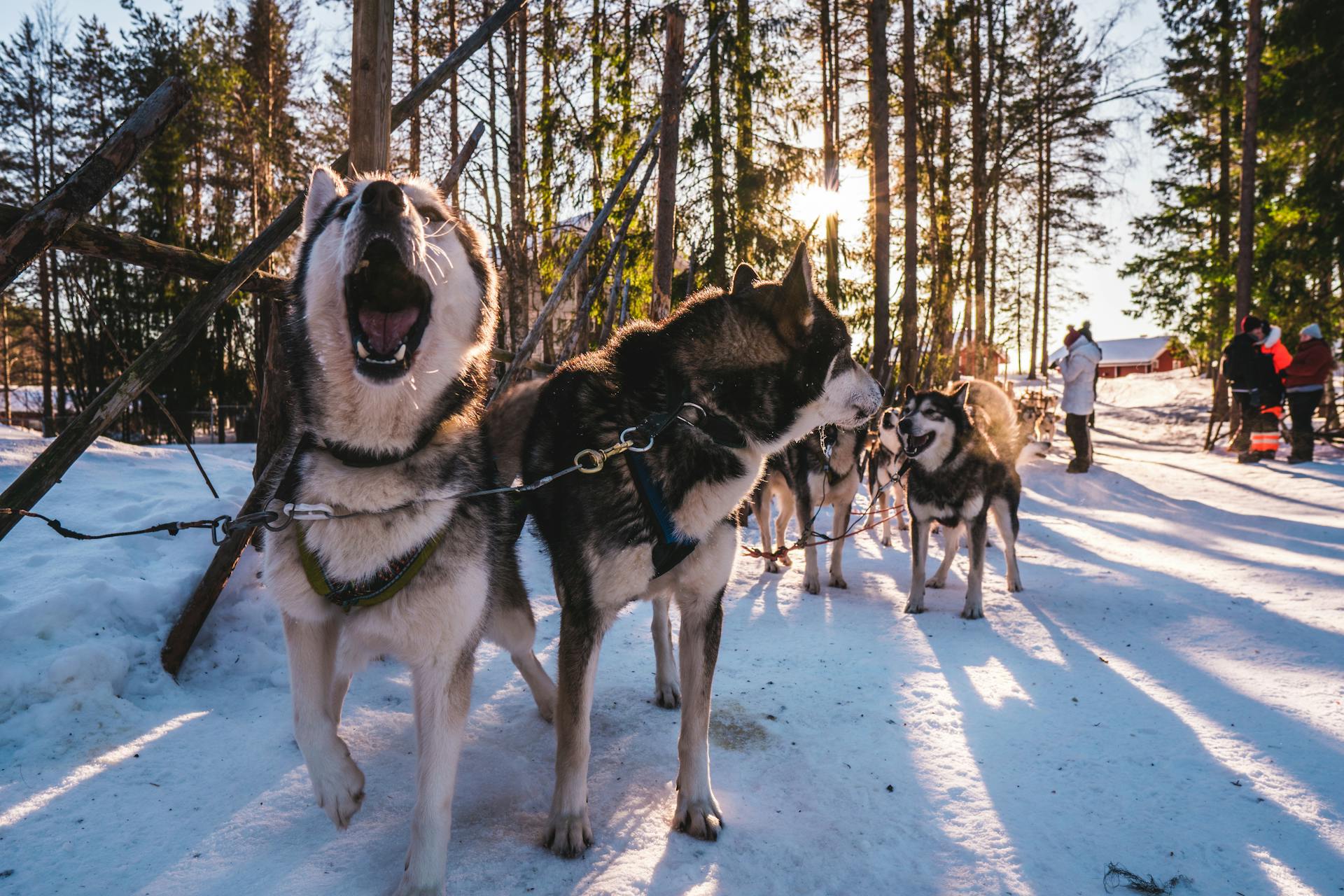
Early socialization is crucial, as puppies that don't spend enough time with their mother and littermates may not learn the difference between gentle nipping and painful bites.
Dogs that aren't properly socialized as puppies may grow up to be problem biters, so it's essential to provide them with plenty of opportunities to interact with people and other animals.
To prevent aggression in Huskies, you can follow these steps: provide proper training and socialization from an early age, teach them to respect personal space, and manage their energy and excitement levels.
Dogs may bite or nip for various reasons, including not being properly socialized, mouthing or nipping during play, or biting out of aggression or fear.
To teach Bite Inhibition to an adult dog, focus on lessening the force of the bite and diminishing the frequency of the bites, using positive reinforcement techniques such as controlled mouthing practice and rewarding gentle behavior.
Mature dogs need to learn to soften their bites, resist biting altogether, and understand cues such as TAKE IT, LEAVE IT, and STOP.
To decrease the pressure of the bite, train your dog to use gentle gumming, issue the cue GENTLE, and reward them with treats and praise.
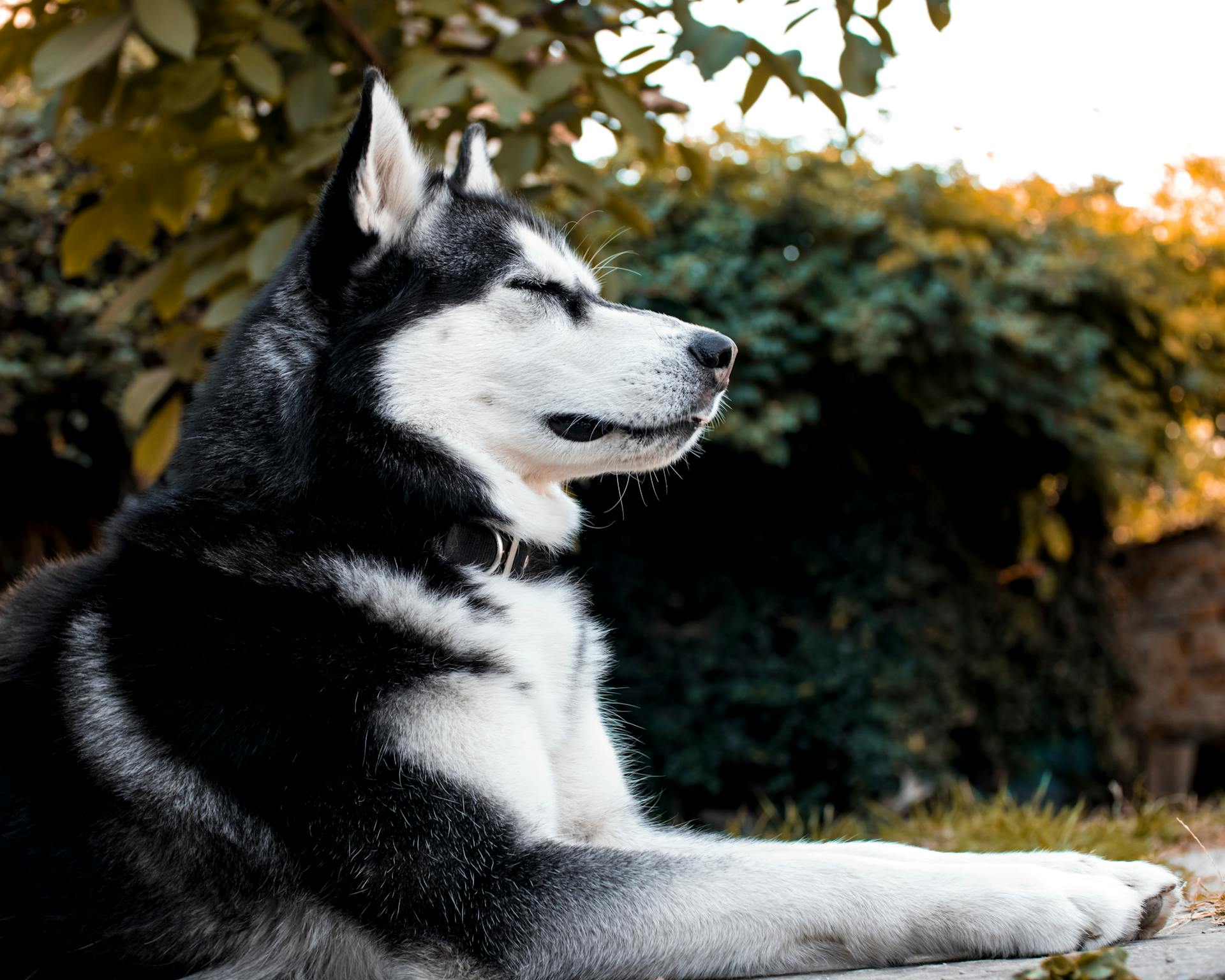
Here are some specific steps to help you teach your dog to stop nipping, biting, or mouthing:
- Place your hand in their mouth for controlled mouthing practice and reward gentle gumming.
- Train your dog to understand cues such as TAKE IT, LEAVE IT, and STOP.
- Use an object placed on the floor to teach your dog to leave it alone and reward them with high-value treats.
- Teach your dog that they must never touch a human with their muzzle or tongue unless invited and initiated by the human.
Reasonable expectations are essential when adopting an adult dog, as they may have existing behavioral problems or lack proper training and socialization.
Offer Enough Exercise
Exercising is a crucial part of keeping your husky healthy, especially if there's no underlying medical condition. Most dogs become aggressive due to excess energy.
Huskies are bred to pull sleds through snow for hours a day, so keeping them indoors can make them lazy with pent-up energy. Introducing a one-hour exercise session can help keep your husky happy and healthy.
You can take your husky hiking after work, or run with them to keep both of you fit and healthy. Swimming, hide and seek, or agility classes can also help your super active husky dog.
Taking your husky to the dog park can be a great option, as they'll engage in various physical activities that keep them fit and healthy. If you can afford it, attaching a safety harness to your bicycle and taking your husky for a ride can be a great way to exercise them too.
On a similar theme: Preventative Care Keeping Your Pet Healthy Year-Round
Dog Bed Related
Dog Bed Related Aggression can be a challenge for husky owners. Your Siberian huskies can portray this behavior, making them protect their bed without letting anyone near it.
Providing enough beds for your huskies can prevent aggressiveness toward each other. You can train them to sleep on different beds to avoid getting attached to a particular bed.
To stop bed-related aggression, you can train your dog to get out of their favorite bed that they like protecting. Show them where to sit or wait as you clean or arrange their beds.
For more insights, see: Dog to Dog Aggression
Leash-Related Issues
Some dogs get aggressive if they're on a leash and wearing a collar because they feel they can't run away from other aggressive dogs or people.
A leash-aggressive dog can bite you when you're putting the leash on, making walks a challenging and potentially hazardous experience.
Your dog might become aggressive toward the leash if it triggers pain or prevents them from achieving their target, causing them to associate the leash with pain or frustration.
To address leash-related issues, you can teach your dog to tolerate the leash and focus on other things, like sitting down instead of pulling aggressively to get off the leash.
Training your dog to lie down if they feel threatened and look at you for assurance can also help calm them down and make walks more enjoyable.
Recognizing Aggression
Huskies can get aggressive when protecting their favorite toy or food from other dogs. This is a natural instinct, but it's essential to teach them that it's not acceptable behavior.
Fear, anxiety, and irritation can turn into aggression if dog owners don't intervene. If your dog is showing signs of fear or aggression, like a tucked tail, pinned ears, raised hackles, crouching, barking, snarling, or lunging, remove your dog from the stressful situation.
Some common signs of aggression in huskies include medical problems, lack of socialization, and resource guarding. Medical problems can be an indicator that their behavior could erupt into violence unexpectedly. Even something as minor as a thorn in their paw or a skin rash could lead to an aggressive outburst.
Consider reading: Pitbull Dog Signs
Here are some warning signs to watch for:
- Medical problems
- Lack of socialization
- Resource guarding
- Territorialism
- Putting a dog into a scary situation
If you notice any of these signs in a husky, it's time to bring in a professional dog trainer and ensure that no children are going to be near the dog in question.
Recognize the Signs
Aggression in dogs can be a serious issue, and it's essential to recognize the signs early on to prevent any harm. A tucked tail, pinned ears, raised hackles, crouching, barking, snarling, or lunging are all warning signs that your dog is feeling anxious or fearful.
If you notice any of these signs in your dog, it's crucial to remove them from the stressful situation immediately. Take them to a quiet place, offer a calming chew, and wait for them to calm down before trying a different activity.
Some common triggers of aggression in dogs include medical problems, lack of socialization, and resource guarding. Medical problems, such as a thorn in their paw or a skin rash, can lead to an aggressive outburst. It's essential to keep your dog's medical issues in check and provide regular check-ups with the vet.
A dog that's never around people can become aggressive due to lack of socialization. If you notice your neighbor's husky is never played with, walked, or bathed, it's a sign that the dog is not well-socialized. Leaving a husky alone or confined for a long time can cause anxiety and lead to aggression.
Baring their teeth, growling, biting, nipping, and raising their fur are all signs of aggression in dogs. These behaviors can indicate that your dog is feeling threatened or defensive.
Here are some common signs of aggression in dogs:
- Baring their teeth
- Growling
- Biting, nipping
- Raising their fur
It's essential to recognize these signs early on and take steps to address the underlying issue. If you're unsure about how to handle aggression in your dog, consult with a professional dog trainer or veterinarian for guidance.
Female Aggression
Female Huskies are often mistakenly believed to be more aggressive than males, but the truth is they're not. Their temperaments are simply different, influenced by personality type.
Female Huskies tend to be introverted, often spending most of their time alone, which can lead to mood swings.
Mood swings don't necessarily mean aggression, and being temperamental doesn't prove anything.
Common Triggers
Husky dogs can be prone to aggression, and it's essential to be aware of the common triggers that can lead to biting. Medical problems in a dog can be an indicator that their behavior could erupt into violence unexpectedly.
A dog who is never around people is a recipe for disaster. If your neighbor keeps their husky chained up in the backyard without any social interaction, it's a sign that the dog is not well-socialized and could get violent.
Dogs can react poorly to scary or unfamiliar situations, such as being given an injection, transported in a small space, or having puppies. Resource guarding is another warning sign, where huskies become aggressive when protecting their food, bed, toys, or other cherished belongings.
Here are some common triggers to watch out for:
- Medical problems
- Never being around people
- Scary or unfamiliar situations
- Resource guarding
Territorialism is also a common trigger, where dogs feel the need to defend what they perceive as "theirs", such as their front yard or favorite spot.
Husky Triggers
Medical problems in a husky can be an indicator that their behavior could erupt into violence unexpectedly. Even something as minor as a thorn in their paw or a skin rash could lead to an aggressive outburst.
Dogs that are never around people are a concern, especially if they're left chained up in the backyard without social interaction. This can lead to anxiety and a higher likelihood of escaping.
Putting a dog into a scary situation can result in a violent, unexpected reaction. For example, if a husky needs to be given an injection or transported in a small space, it might lead to an outburst of violence.
Resource guarding is another warning sign, where huskies get violent when protecting their bed, toys, or other cherished belongings. This is closely related to territorialism.
Territorialism is a common issue in huskies, where they defend what they perceive to be "theirs". This can manifest as marking territory with urine or becoming aggressive when other dogs enter their perceived territory.
Here are some common husky triggers to watch out for:
- Medical problems or pain
- Isolation or lack of socialization
- Scary or unfamiliar situations
- Resource guarding
- Territorialism
Food Related
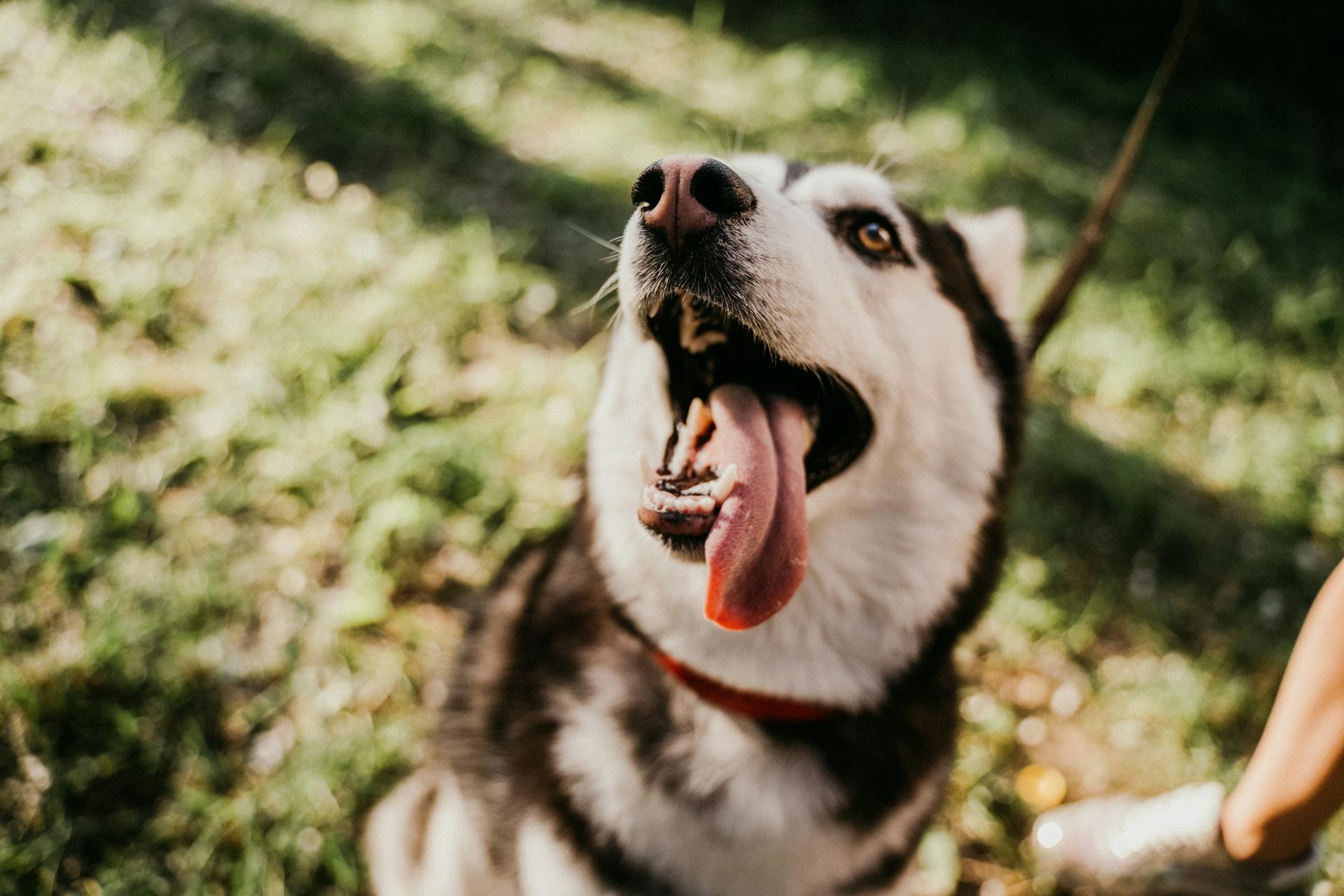
Food Related Aggression is a common issue in Siberian huskies, characterized by guarding their food and becoming dominant and aggressive to protect it.
Your husky may become irritable and anxious when hungry, leading to aggressive behavior. This can be triggered by the presence of other dogs or people near their food.
To combat food aggression, it's essential to establish a designated feeding area where your husky can eat without being disturbed. This will help prevent them from feeling threatened or territorial.
Make sure your demeanor is relaxed during feeding time, as this will help calm your dog and reduce aggression. You can start by sitting or standing 15 feet away and remaining quiet and still as your husky eats.
Reward your husky for remaining non-aggressive during feeding time. Positive reinforcement is key to managing food aggression.
Here are some tips to help you identify and manage food-related aggression:
- Give your husky food in a location where they won't fight with other dogs.
- Train your husky on pack behavior, where they learn to leave their food when someone is around and wait until the person moves away.
By following these tips and being consistent, you can help your husky overcome food-related aggression and develop better habits around food.
Frequently Asked Questions
Do Siberian Huskies have a strong bite?
Siberian Huskies have a moderate bite force of around 320 psi, which is relatively strong but not excessively so. Their friendly nature and gentle temperament make them a great choice for families and first-time dog owners.
Sources
Featured Images: pexels.com
